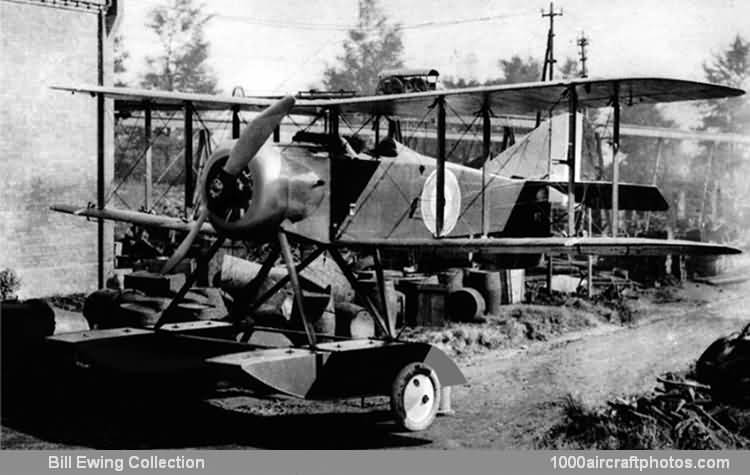07/31/2019. Remarks by Johan Visschedijk: "In 1916, with a growing number of Royal Navy ships capable of carrying and launching aircraft with wheeled landing gears or floats, the Air Department of the Admiralty was examining the potentialities of single-seat fighters. It was also considering the means whereby such an aircraft could be designed and produced to meet naval requirements. Thus the Air Department N.1B requirement was for a single-seat shipboard floatplane or flying boat fighter having a speed of 110 mph (177 kmh) at 3,048 ft and a ceiling of at least 20,000 ft (6,096 m). This latter requirement was particularly exacting, bearing in mind the comparatively low power/weight ratios and levels of reliability of the engines available at that time.
Three aircraft manufacturers prepared designs to meet this requirement; they were the Blackburn Aeroplane and Motor Co, the Supermarine Aviation Works and Westland Aircraft Works. Both the Supermarine and Blackburn designs were pusher biplane flying boats but the other design, the first to emanate from the Westland Aircraft Works, was a more conventional tractor biplane floatplane. Contracts for the construction of a total of eight prototypes, all designated N.1B, were placed with the three companies; three each by Blackburn and Supermarine and two by Westland.
The design of the two Westland N.1Bs was the work of Robert Bruce and Arthur Davenport, the company's manager and chief draughtsman respectively. The construction, understandably, followed the standard pattern of that era. The fuselage was a conventional rectangular-section structure with four longerons and internal wire-braced frames of spruce with steel end fittings, the front ends of the longerons carrying the mounting for the 150 hp Bentley AR.1 (for Admiralty Rotary) nine-cylinder air-cooled rotary engine driving a 9 ft (2.74 m) diameter wooden propeller. Wooden formers on the upper longerons provided a rounded top surface to the fuselage. The cockpit surround was of leather-edged plywood and had a small head fairing. The entire tail unit was an externally wire-braced wooden structure.
The constant chord two-bay biplane wings were built up around two ash main spars with wire-braced spruce struts and ribs, and spruce interplane struts. Ailerons and trailing edge flaps, described as a 'wing camber-changing device patented by Robert Bruce', were fitted on all four wings. The wings were designed to fold back against the fuselage sides for shipboard stowage without requiring a jury strut to be fitted at the front spar root-end fittings. Wire-braced spruce alighting gear struts carried two rectangular-section floats, each with a number of watertight compartments. Control wires to the elevators and rudder were run externally from the cockpit but those to the ailerons and flaps were routed inside the wings. The airframe was fabric covered with a metal engine cowling and top and side panels at the forward end of the fuselage.
Armament was a fixed forward-firing Vickers 0.303 in (7.7 mm) machine gun, synchronized to fire through the propeller disc and mounted in a metal 'hump' fairing on top of the fuselage in front of the cockpit, plus a Lewis 0.303 in gun on a swivel mounting on the upper center section above the cockpit. A cross-bar on the center section leading edge appeared to serve the dual purpose of preventing the gun from being fired through the propeller arc and serving as a front mounting for the gun fixed to fire either slightly to port or starboard. In addition two 65 lb (29.5 kg) bombs could be carried in tandem on tubular carriers attached on the aircraft's center line under the fuselage.
Two N.1Bs were built by Westland with some minor differences between them. The first, serialed N16, was fitted with 11 ft (3.35 m) long Sopwith main floats and a 5 ft (1.52 m) long tail float carrying a water rudder which was moved by a vertical shaft extending down from the aircraft's rudder. In the second aircraft, serialed N17, these were replaced by Westland-designed floats 17 ft 6 in (5.33 m) in length with swept-up aft ends which made the tail float unnecessary. Some reports indicate that these floats could be fitted with a through axle carrying two wheels to enable the N.1B to take off and land on suitably equipped vessels at sea, but no evidence of this design feature can be traced. The wheels that are shown in photographs are almost certainly those of a ground-handling trolley.
Completed during the summer of 1917, in August the renowned Harry Hawker flew N16 on its first flight from Yeovil. In October at least one Westland N.1B, N16, and possibly both aircraft, went to the Royal Naval Air Service Experimental Construction Depot at Port Victoria on the Isle of Grain for evaluation where it was flown by Squadron Commander J.W. Seddon who, in 1913, as a young Lieutenant RN flying instructor, had had as a pupil the fledgling aviator and the First Lord of the Admiralty, Mr. Winston Churchill.
The reports of its evaluation against the PV.2, built by the Royal Naval Air Service Depot at Port Victoria, showed that the Westland N.1B performed well and exhibited good handling characteristics; however, before the type could be developed, a change of policy ensued. Landplane single-seat fighters, such as the Sopwith Pup and Camel, had demonstrated their ability to take off and land on vessels underway at sea, thus removing the need for the carriers to heave to and either drop or pick-up seaplanes. Because of this change of emphasis, further production and development of the Blackburn, Westland and Supermarine N.1Bs was abandoned after cancellation of the contracts in 1917."
